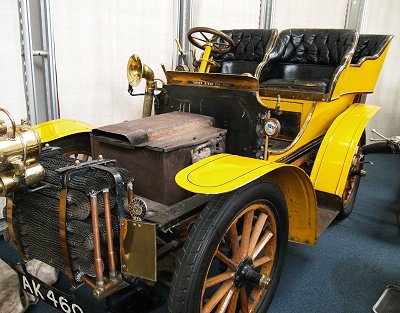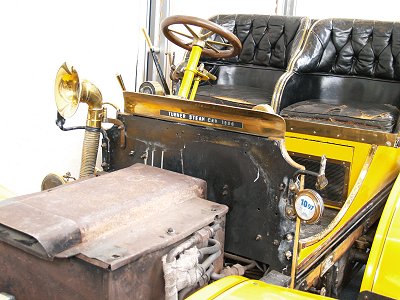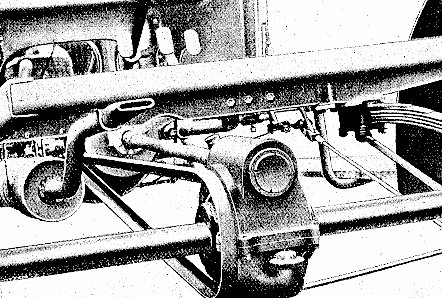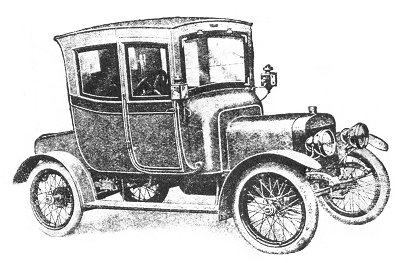| The Turner Manufacturing
Company originated as an engineering business around
the middle of the 19th century in a small workshop
by the Dumbell family's house in Great Brickkiln
Street. In 1902 the company’s owner, James Burns Dumbell, a very astute businessman, decided that the
way forward lay in the production of motor cars, and so
the manufacturing rights of a well established vehicle,
the Belgian Miesse steam car were obtained from the
Brussels based company of J. Miesse. The Miesse steam
cars were a first class design and proved to be very
popular in Europe. At this time petrol engines were not
always reliable and so there was a place in the market,
albeit briefly, for steam cars.
The Turner-Miesse
steam cars were initially produced at the company's works
on the corner of Walsall Street and St. James Street,
Wolverhampton, where Hydrafit Limited is today.
The building had previously been Walsall Street
School for boys, girls and infants. It would have
been an ideal building to be converted into a
factory. |
 |
|

A 1903 advert. |

The Turner-Miesse steam car from
1904 that's on display at the Black Country Living
Museum, Dudley. |
The car had a three cylinder, single
acting engine (steam only admitted above the piston)
with a paraffin-fired flash boiler.
The engine had a
bore of 50 mm and a stroke of 80 mm, and used poppet
valves.
The flash boiler
was of the Serpollet type with a pressure of 50 to
600 p.s.i. depending upon the load from the engine.
|

Drawing courtesy of David Beere.

The location of the Walsall Street factory.
|

The old Turner Walsall Street
factory, as seen in April 2016. |
|

Another view of the factory. |

John Tilley and Ray Salisbury in
the 1904 Turner-Miesse car on a wet day at the Black
Country Living Museum . |
Initially Turners purchased the complete
running chassis from Miesse and added the
body. Eventually the company built the whole car, as
stated in the 1903 advert above. The 1904 car at the
Black Country Living Museum was recently restored by
John Tilley, an expert on steam cars. He found that many
of the parts carried Belgian names, and so they must
have been imported. All of the nuts and bolts on the car
are metric, so it is likely that it was built by Miesse. |
| The transmission was by a spur
gear, direct from the crankshaft to the differential
countershaft, with cranks, side chains, and a dead axle.
The body was of the Tonneau type, meaning that it had an
open rear passenger compartment.
In 1904 the car sold for £485
(excluding lamps, hood and windscreen), and Turner also
offered a luxurious landaulette for about £800. |

An advert from 1904. |
|

A Turner-Miesse Landaulette. |
The fuel
consumption was as follows:
3 miles to a
gallon of water
(16 gallons could be carried).
10 miles to a gallon of paraffin
(9 gallons could be carried).
The car could
achieve a maximum speed on the level of 33 m.p.h. with a
running cost of about one halfpenny per mile. It
achieved some success in hill-climb competitions, where
it always got to the top, even if it took time to do so.
The company also built some steam-powered commercial
vehicles. |
| The steering wheel
and controls of the 1904 Turner-Miesse steam car that's
on display at the
Black Country Living Museum. |
 |
 |
Another view of the car with
the bonnet removed to show the cover over the steam
engine. |
| A closer view of the engine
compartment. |
 |
 |
The car's two steam gauges and
associated pipework. |
| The crankshaft from the the
1904 Turner-Miesse steam car that's
on display at the
Black Country Living Museum. |
 |
 |
The cylinder block and pistons
from the 1904 Turner-Miesse steam car that's
on display at the
Black Country Living Museum. |

From 'The Motor-Car Journal' November 24th,
1906. Courtesy of Ray Jones.

From 'The Motor-Car Journal' November 24th,
1906. Courtesy of Ray Jones.

| Miesse ended their involvement
with Turner in 1907 when the sales of steam cars began
to decline. Turners then manufactured steam cars
of their own design, which was very different to the
earlier models. The cars were produced
in ever decreasing numbers until 1913. In 1906 the firm became a private
limited company under the name of the Turner Motor
Manufacturing Company Limited, based at Wulfruna Works
in Lever Street, with Mr. J. B. Dumbell as Managing
Director.
|

An advert from 1910. |

Another advert from 1910.
|

An advert from 1909. |
Around the same time they began
to manufacture their first petrol engined cars under the
name of Seymour-Turner.
Seymours were London based dealers
and the new car made its first appearance at the 1906
Motor Show.
Production only lasted for one
year and so only small numbers could have been built. |
| The first petrol car to carry the
Turner name appeared at the 1908 Motor Show at Olympia.
The light car, a 2 seater, was powered by a 9 hp. air
cooled ‘V’ twin engine and had a 2 speed gearbox.
Other models soon followed. In
1909 a car powered by a 10 hp. four cylinder,
water-cooled engine, went into production and sold for
£182.
This was soon followed by a larger
15hp. model. Sales were good, both at home and abroad. |

The Turner 2 seater petrol car that's
on display at the Black Country Living Museum, Dudley.
It was built in 1911. |
 |
An inside view of the Turner 2 seater petrol
car at the Black Country Living Museum, Dudley. |
| The 9 hp. Turner petrol car sold for £135 at the
beginning of 1912. It had an air-cooled engine with
accumulator-coil ignition. A more expensive model,
priced at £150 had a water-cooled engine and
magneto-ignition. The car had a pressed steel body,
inswept at the front to provide ample steering lock, and
a subsidiary frame to which the engine and gearbox were
attached. |

The 9 hp. twin cylinder car from
1912. |
|

An advert from 1913. |
The vertical twin cylinder 'V' type engine had an
external flywheel and a gearbox with two forward speeds,
reverse, and a free position. The engine bore was 86 mm
with a 92 mm stroke. The engine was transversely mounted
in the channel-steel frame, just behind the driving
seat. Half-elliptic springs were fitted at the front of
the car, and quarter-elliptic springs at the back to
give a very comfortable ride. The car weighed-in at just
over 7 cwt. and came complete with a kit of tools, but
the lamps, horn, screen, and hood were extras. |

The 1912 10 hp. Turner light car.
|

An advert from 1913. |
|

Another view of a Turner light
car, minus the bodywork.
The car had a four-cylinder
engine, chain driven timing gear, thermo-syphon cooling,
and magneto ignition.
The back axle was worm-driven
from a cone-clutch, and three-speed, and reverse gear
box. |
| The Turner 10 hp. four-cylinder
engine that was fitted to the light car. |
 |
 |
The worm-driven back axle in
the 10 hp. Turner light car. |
| The Turner 10 hp., 4-cylinder,
water cooled, petrol car that's on
display at the Black Country Living Museum, Dudley. It
was built in 1912. |
 |
 |
A close-up view of the 10 hp.
car that's on display at the Black
Country Living Museum. |
 |
A close-up view of the Turner Ten. |
|
An advert from 1913. |
 |

John Lawson's immaculate 12/20 hp.
Turner 2-seater, open Tourer, from 1914, the only one
known to exist. The car is currently for sale on ebay
(as of March 2015). Courtesy of John Lawson. |
 |
Another view of John Lawson's
unique car.
It has a 4-cylinder 1822 cc. monobloc engine, with
overhead inlet and side exhaust valves. It also has a magneto, a Zenith up-draft carburettor and
forced lubrication to the main and camshaft bearings by oil pump. It
is fitted with a cone clutch, and a four-speed gearbox with gate change.
Courtesy of John Lawson. |
|

A look inside the engine
compartment. Courtesy of John Lawson. |

An advert from 1914.
| In 1914 the company began to
produce cars under the ‘Universal’ name for the
Universal Car Company of London.
The cars sold for £250 but the First
World War intervened and car production ceased in favour
of components and machine tools for the war effort. |

The 'Universal' from 1914. |
| In 1919 Turners became involved
in an unfortunate venture with Varley Woods. The Varley
Woods cars were unsuccessful and the venture ended when
Turners obtained a winding-up order against Varley Woods
for non payment of rent on their Wolverhampton premises.
 |
|

An advert from 1922. |
|

An advert from 1923. |
|

An advert from 1923. |
Turner cars eventually reappeared
in 1923 with the 'Twelve Forty' which sold for £375.
The same year saw the appearance of the 'Twelve Twenty'
which was powered by a 4-cylinder 1496 cc. Dorman
engine. It had a 3-speed gearbox, electric lighting and
starter. |
| The following year saw the
introduction of the ‘Colonial’ model that was powered by
a 2 litre Meadows engine. Unfortunately the company found
it difficult to compete with the larger manufacturers,
and as a result car production ended in 1928, in favour
of production of components for the motor and aircraft
industries. |
 |
Return to
the
previous page |
|



